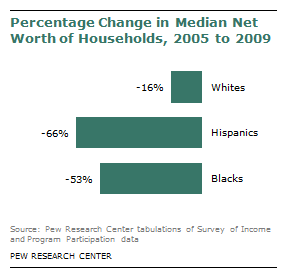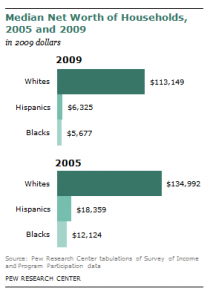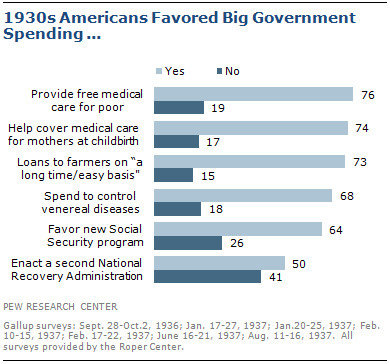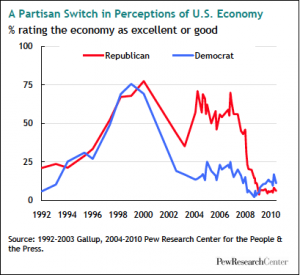Pew published this article:
Wealth Gaps Rise to Record Highs Between Whites, Blacks and Hispanics Twenty-to-One
By Rakesh Kochhar, Richard Fry and Paul Taylor, Pew Research Center’s Social & Demographic Trends
July 26, 2011
“The median wealth of white households is 20 times that of black households and 18 times that of Hispanic households, according to a Pew Research Center analysis of newly available government data from 2009.
These lopsided wealth ratios are the largest since the government began publishing such data a quarter century ago and roughly twice the size of the ratios that had prevailed between these three groups for the two decades prior to the Great Recession that ended in 2009.How is net worth defined? It is assets minus debts. Given the collapsing housing market, many people’s assets ain’t what they used to be. In addition, some people are finding that carrying debt is costing more now that interest rates credit companies can charge has been deregulated. At 20% or more, getting out of debt will be hard, even if the economy begins to provide enough jobs for everyone who wants one.
PEW also noted that the losses in net wealth has been greater among blacks and Hispanics.

PEW writes:
“From 2005 to 2009, the median level of home equity held by Hispanic homeowners declined by half — from $99,983 to $49,145 — while the homeownership rate among Hispanics was also falling, from 51% to 47%. A geographic analysis suggests the reason: A disproportionate share of Hispanics live in California, Florida, Nevada and Arizona, which were in the vanguard of the housing real estate market bubble of the 1990s and early 2000s but that have since been among the states experiencing the steepest declines in housing values.
White and black homeowners also saw the median value of their home equity decline during this period, but not by as much as Hispanics. Among white homeowners, the decline was from $115,364 in 2005 to $95,000 in 2009. Among black homeowners, it was from $76,910 in 2005 to $59,000 in 2009. There was little or no change during this period in the homeownership rate for whites and blacks; it fell from 47% to 46% among blacks and was unchanged at 74% among whites.”
To read the article: see:
Wealth Gap Article



